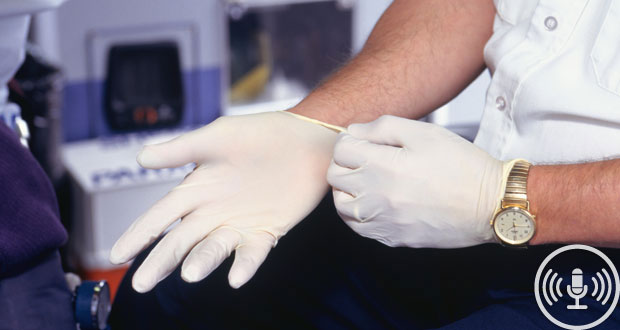Communication, vigilance essential for clean hands away from hospital

Maintaining good hygiene outside of controlled environments is a challenge that must be met.
With companion animals and cluttered workspaces to deal with, infection control in the community can be challenging. Still, nurses and community-care workers must not lose sight of the importance of hygiene practices.
This is one of the key points raised by Linda Raymond, regional wound management clinical nurse consultant with Latrobe Community Health Service, in a recent editorial in the Australian Nursing and Midwifery Journal.
Writing on behalf of the Regional Wounds Victoria (RWV) collaborative, which is funded by the Commonwealth and Victorian governments under the Home and Community Care program, Raymond stated: “While the environment is not controlled and home hygiene standards are not usually at a hospital standard, this does not mean that care in the community should be compromised.”
Nursing Review sat down with Raymond to discuss the unique challenges health professionals working in community settings face when it comes to hand hygiene and what must be done to ensure workers and clients are supported in this and related areas.
NR: You said that over the past 20 years there has been a shift in healthcare provision, with an increasing proportion of complex care previously undertaken by healthcare workers in acute care settings now being provided in the community. What impact does this shift have on the importance of keeping on top of infection control?
LR: Healthcare workers in community settings often work alone and usually have to make quite swift decisions and risk assessments. The push for hospitals to discharge patients earlier means more complex care is being attended to in the community. Also, as we know, we have an ageing population, and with the advances in healthcare we have an increasing number of people requiring care in the community.
Healthcare workers are now attending to more complex and invasive care. We have IV therapy and ventilation and catheterisations. Many clients are not only elderly but also terminally ill, or are recovering from major surgery, they’re immunocompromised, [they’ve had] chemotherapy, and have chronic diseases. Nurses have to carry more equipment to be able to attend to all of these needs. How this is transported and cleaned is a major infection-control issue, along with basic hand hygiene. It’s become far more complex.
What are some of the other unique challenges health professionals working in community settings face when it comes to hand hygiene?
We visit clients’ homes, which is always a privilege to be able to do, so we are going in as a guest; however, we still have a job to perform and we need to do that well. These homes can be anything from palatial to small caravans. Some nurses and community health workers attend to people who live on the streets, although I haven’t done that.
Some of these homes are kept fastidiously clean. I’ve been into some homes where you could eat off the floor, [but you can also] go into absolute squalor.
How does the healthcare worker attend to a procedure in this environment when it’s even difficult to devise a sterile or even clinically clean workplace? Does the risk assessment that’s completed before we’re meeting this client address being able to do what your service is required to do safely in this home?
OH&S comes into play as well. Healthcare workers don’t have a lot of ability to raise beds as you do in the hospital. They don’t have bariatric equipment or hoists, or anything like that. You’re also having to do this procedure in a difficult position. You might be on a low bed or on a chair, or it might involve attending in a double bed and having to reach across it. These obstacles come into play.
You described a scenario in which a nurse was attempting to dress a foot wound while contending with a front gate, dogs running about, and working in a restricted space. What are some of the common infection-control issues that may slip to the back of workers’ minds in particularly challenging situations? What thoughts should be front and centre?
It’s the unexpected. In that scenario I was endeavouring to capture some of the subtle breaches in hand hygiene. You need to be vigilant at all times. For instance, if you’re a theatre nurse, you’re gloved and gowned, so you’ve got that reminder. You’ve got the mask on, you’ve gone through that whole ritual of that intensive hand washing, you’ve got your gown on, and if you did inadvertently bring your hand up and touch your nose, somebody’s probably seen that, and gone, ‘Hey! We have to start again,’ and out you go and you do your procedure again.
In the community, in contrast, we work autonomously. We haven’t got someone watching us. In that scenario [with the foot wound], if the nurse lost her balance and put her hand to the ground, what should happen in that situation? You’ve contaminated that hand, that glove. You would actually have to get up, you’d have to start again, remove the glove, do hand hygiene again, and re-don your gloves. These are the subtleties that I was trying to get at with that scenario. I thought I’d captured quite a lot in there.
The healthcare worker needs to be mindful the whole time that they are within this environment, and even to step through in their head where all the pitfalls could be. In that situation, where the nurse was in a confined space, that was probably not the ideal place to attend to that dressing. This is another part of what we need to think about. When we’re in someone’s home, where are we going to attend to this dressing? What can we have set up? Because this is probably an ongoing thing, it’s not just a one off. How can we do this in a safe way and reduce the chances of the nurse or healthcare worker hurting themselves or the client, because they need to be in a comfortable position where you can do the procedure in a way that won’t inadvertently breach hand hygiene standards.
You said that although providing the same level of infection control practised in hospitals in the community setting can be quite challenging, that doesn’t mean it should be compromised. What are some strategies community care workers can employ to ensure they provide clean, safe and competent care?
Training, particularly from a nursing point of view, occurs in a controlled environment. We’ve had our training either in a university, in the clinical labs, or in the hospital. We’ve got wash stations positioned everywhere. There’s hand hygiene often at the end of every bed, and on every procedure trolley. We’ve got reminders, we’ve got posters up, we have access to infection-control consultants who provide education, and, of course, attending audits.
This doesn’t happen in the community. Hand Hygiene Australia has online education and competencies, but [completing that] doesn’t mean that you’ve comprehended the complexities of those procedures, or when and where to do hand hygiene. I’ve seen numerous breaches of basic hand hygiene principles by experienced nurses and it’s because they’re not thinking. Bad habits can form when you’re working autonomously and you’re not seeing the reminders.
Also, sometimes [misinformation can be spread]. Someone says, ‘Oh, that’s OK, you don’t need to change your gloves there, you’re not going to contaminate, that’s fine,’ and this sort of thinking goes ahead.
We don’t have training for community workers that takes them out of hospital settings and puts them into that farmhouse. [Training needs to ask important questions.] What would happen? What would you do in this situation? If this happened, what would you do? Would you change gloves? Would you wash your hands? Would you just use hand hygiene? These are the scenarios that need to happen in a safe place where these things can be expounded upon, [with] nurses and healthcare workers watching others and commenting on what they see. Was that the right thing? Was that the wrong thing?
What can be done on a broader level to support community care workers in this area?
Education in a safe environment that provides the scenarios and the role-playing, like I just discussed. Then followed by real-time observation and, perhaps, auditing. Someone in the team [should have] the role of infection control and perhaps hand hygiene, someone that’s a bit passionate about this and is happy to guide other staff with this and provide that education.
Also, consider having two nurses or healthcare workers going out together. Often, you haven’t got that second pair of hands. When you’re in the hospital, you can ask for another’s assistance. You can get your buddy nurse from the ward next door to come and help. Often the clients can help you, and sometimes their own family members are fantastic. It doesn’t take much to train someone else to help you in the environment to open up and assist you, but you might not always have that. So should we consider perhaps sending out two nurses or healthcare workers at a time?
Budget constraints are always going to dictate what we can do. Budgets are getting tighter and tighter. But in the long term, are we saving money if we are creating infection?
Organisations also have to support healthcare workers with correct procedures and policies for hand hygiene. They also must be able to provide direction for education and ongoing education for all staff.
Overall, what message do you hope community care workers take away from your editorial?
To think about their own practice and to discuss it amongst themselves, amongst their colleagues, and with their managers. Also we need to educate our clients as well. I’d like to see a brochure that’s given to the client that explains the standards that should be happening regarding when gloves should be changed, when hand hygiene should be attended to, and what the client can do to facilitate those things within the home.
We’re not saying that they have to clean the whole house [but] we need to explain that we need an area, we need a table that we can use that’s clear of clutter, where we can lay things out, and what that’s for.
Nurses and other healthcare workers need to be vigilant about what they take into clients’ homes. I’ve just read an interesting article about the swabbing of nurses’ and healthcare workers’ bags. That gave a lot of food for thought [about] the microorganisms that are growing on the bags. What is the cleaning regime of what you take into a client’s home? Do you have something separate for each client, or is it the same bag going in and out of everyone’s home? They’re getting put into cars. Cars get hot. Cars get cold. These things all affect infection control and sterilisation.
I’m not an infection-control nurse, but if you have a look at the standards, you will see that there are certain temperatures that these items are not supposed to go over. The item is then rendered non-sterile. Moving packaging too much can breach the sterility.
It’s a huge undertaking, but it’s one that needs to be addressed because more and more we’re going to be providing care in the home and in community settings.
Email: [email protected]





